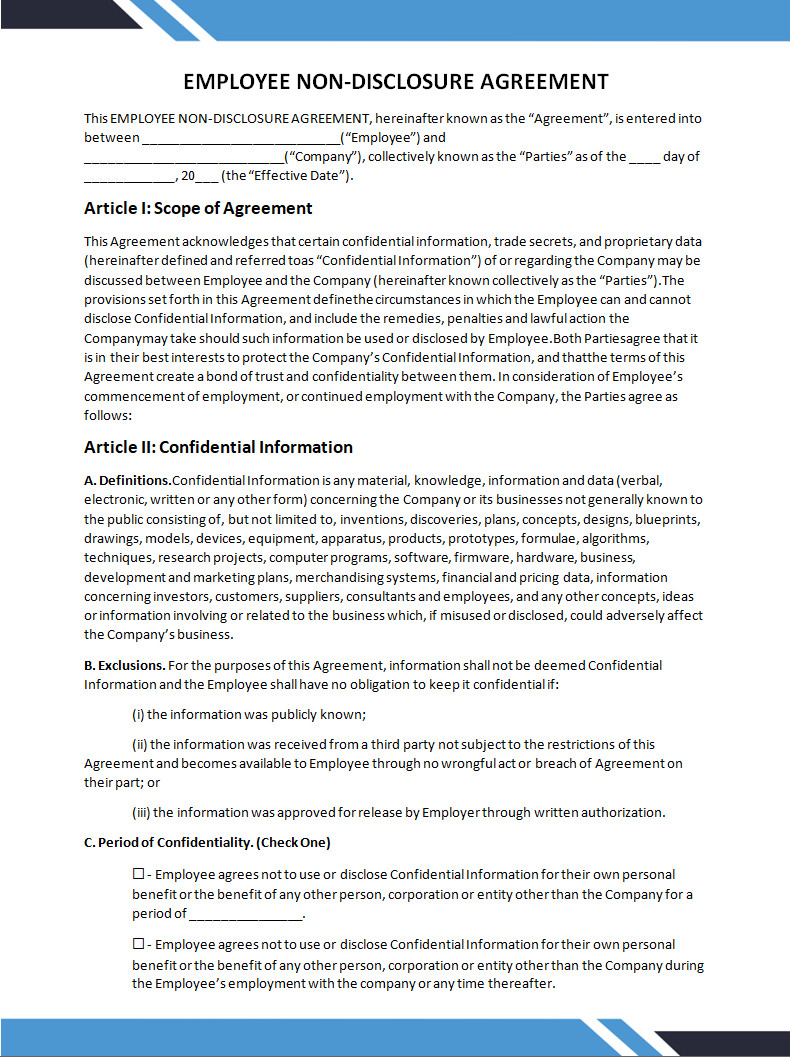
What is a Non-Disclosure Agreement?
A non-disclosure agreement, commonly known as an NDA, is a legal contract between an employer and an employee that outlines the confidential information that the employee is privy to during their employment.
The agreement prohibits the employee from disclosing this information to third parties, including competitors, after their employment has ended.
What to Include in a Non-Disclosure Agreement?
When drafting a non-disclosure agreement for employees, it is important to include the following key elements:
Definition of Confidential Information
Clearly specifying what constitutes confidential information is essential for an NDA. This can include a detailed list of the types of information that are considered confidential, as well as any exclusions or exceptions. By providing a comprehensive definition, both parties have a clear understanding of what information is protected under the agreement.
Obligations of the Employee
The NDA should outline the employee’s responsibilities regarding the confidentiality of the information they have access to. This can include guidelines on how the information should be handled, stored, and shared, as well as the consequences of breaching the agreement. By clearly articulating the employee’s obligations, the company can ensure that sensitive information is protected.
Duration of the Agreement
Specifying the duration for which the NDA will remain in effect is important for clarifying the timeline of the confidentiality obligation. This can vary depending on the nature of the information and the industry in which the company operates. By clearly defining the duration of the agreement, both parties are aware of how long the confidentiality obligations will last.
Exceptions to Confidentiality
It is essential to include any exceptions to confidentiality in the NDA to account for situations where disclosure of confidential information may be necessary. This can include legal obligations, government requests, or disclosures required for business operations. By outlining these exceptions, the NDA remains flexible while still protecting sensitive information.
Enforcing a non-disclosure agreement requires proactive measures to ensure compliance and address any breaches promptly. Here are some steps to effectively enforce an NDA:
Educate Employees
Providing comprehensive training on the importance of confidentiality and the terms of the NDA is crucial for ensuring compliance. Employees should understand the implications of violating the agreement and how their actions can impact the company. By educating employees on their obligations, the company can reduce the risk of breaches.
Monitor Compliance
Regularly monitoring employee activities and access to confidential information can help detect any unauthorized disclosures or breaches of the NDA. This can involve implementing security measures, conducting audits, and reviewing employee communications. By actively monitoring compliance, the company can identify any potential issues early on and take corrective action.
Take Legal Action
If a breach of the NDA occurs, it is essential to consult with legal counsel to determine the appropriate course of action. This may include sending a cease and desist letter, seeking injunctive relief, or pursuing legal remedies for damages. By taking swift and decisive legal action, the company can protect its confidential information and send a clear message about the importance of confidentiality.
Tips for Drafting an Effective Non-Disclosure Agreement
When creating a non-disclosure agreement for employees, consider the following tips to ensure its effectiveness:
Be Specific
Clearly defining the confidential information covered by the NDA is essential for avoiding any ambiguity. Include specific details about the types of information that are considered confidential and how they should be handled. By being specific, both parties have a clear understanding of their obligations.
Use Clear Language
Write the NDA in clear, understandable language to prevent misunderstandings or misinterpretations. Avoid using technical jargon or complex legal terms that may confuse employees. By using simple language, the agreement is more likely to be followed and enforced effectively.
Consult Legal Counsel
Seeking guidance from legal professionals when drafting an NDA is crucial for ensuring that the agreement complies with relevant laws and regulations. Legal counsel can provide valuable insights into best practices, potential risks, and ways to strengthen the agreement. By consulting with legal experts, the company can create a robust NDA that offers maximum protection.
Non-disclosure Agreement Template for Employees – WORD